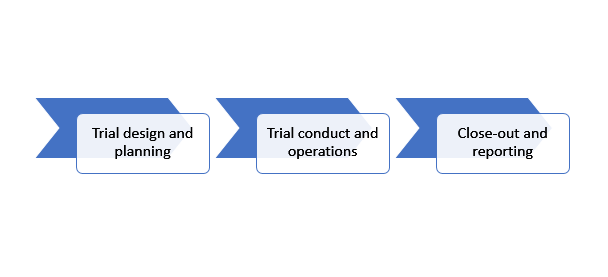Despite advancements in digitization and remote or decentralized trials, traditional clinical trials with a central site, in-person recruitment and monitoring, and paper-based or electronic regulatory submissions continue to remain critical for the approval of new drugs, medical devices, and biologicals. Despite the reliance on clinical trials for deciding the fate of drugs, it is surprising to note that a large percentage of clinical trials fail to succeed in various phases from Phase I-III. Other than problems associated with the safety and efficacy of new products which are associated with the drug development process, factors that cause trials to fail are related to poor trial development such as study design, inadequate dose selection, analysis issues, inadequate endpoints, and assessment schedules. Furthermore, patient recruitment and retention challenges, data collection and management issues, and failure to comply with regulatory standards are also some hurdles that impact the progress of clinical trials. As sponsors are responsible not only for financial oversight of clinical trials but also help in the development of the protocol, ensure regulatory compliance, recruitment, and overall study oversight, it is important for sponsors to be aware of and implement strategies that can help boost the chances of successful trials that can further advance treatment options for various diseases.
Clinical trials proceed through various phases after drug discovery and target validation, and pre-clinical studies in animal models to Phase I-IV studies that involve healthy volunteers and patients. Each phase of a trial has a specific objective that involves determination of safety, efficacy, comparative effectiveness, side effects profile, and finally real-world data from usage of the drug post-marketing approval. However, the trial process remains relatively the same for Phases I-III that are performed at study sites under constant supervision and monitoring my study personnel in a controlled environment.
The figure below shows the three broad steps in a typical clinical trial process:
 At ProRelix Research we believe in helping sponsors select best practices and implementation strategies to result in successful clinical trials. The following tips will help sponsors stay on track with their trials, obtain meaningful and reliable data, and help disseminate the data to relevant stakeholders and regulatory agencies. Tips for effective planning, execution, and management are expected to increase the probability of success of clinical trials and are as follows:
At ProRelix Research we believe in helping sponsors select best practices and implementation strategies to result in successful clinical trials. The following tips will help sponsors stay on track with their trials, obtain meaningful and reliable data, and help disseminate the data to relevant stakeholders and regulatory agencies. Tips for effective planning, execution, and management are expected to increase the probability of success of clinical trials and are as follows:
Trial design and planning
- Definition of a clear and achievable objective and endpoint(s) that address the research question and are easily measurable and can include biomarkers.
- Choice of an optimal study design (inferiority, non-inferiority, or equivalence designs) that is linked to the objective of the study and helps to prove the hypothesis which should be defined prior to the start of the study.
- Calculation of appropriate sample size of participants for the study that is important to meet the endpoint and is in accordance with the statistical power of the study.
- Development of a protocol in collaboration with investigators that clearly outline the objectives and procedural details of the trial such as eligibility criteria, treatment procedures and schedules, duration of follow-up, data collection methods, study visits and assessments, and statistical analysis plans.
- Choice of a suitable clinical outcome assessment (COA) or patient-reported outcome (PRO) instrument that is valid and can be electronically administered particularly to capture quality-of-life measurements.
- Assembly of a qualified investigator team and selection of study sites that are trained on trial-relevant procedures and can execute the protocol within the defined time.
- Development of training programs for investigators and study personnel to establish standardized practices on protocol execution that help ensure data quality and integrity.
- Robust and comprehensive participant/patient recruitment programs that help to enrol a suitable number of patients in the specified period of the study. Recruitment programs should help patients build trust in the trial and can employ artificial intelligence (AI) tools, social media, and digital platforms to recruit and retain participants.
- Deployment of electronic data capture (EDC) systems and data collection systems that are validated for accuracy, completeness, and consistency and are audited prior to use to increase patient engagement and retention.
- Prioritize engagement with regulatory agencies at the planning stage of trials to obtain sound guidance and advice on trial conduct that help the trial to progress seamlessly.
Trial conduct and operations
- Development of standard operating procedures (SOPs) and quality manuals that describe step-wise procedures for trial activities that help maintain data consistency and accuracy especially in multiple site or remote trials.
- Adherence to ethical principles outlined by institutional review boards (IRBs) or independent ethics committees (IECs) that ensure protection of safety and well-being of participants.
- Conduct internal audits and schedule regular site visits to oversee trial progress and ensure compliance with the protocol, good clinical practices (GCP) guidelines, and regulatory standards.
- Maintain a suitable documentation or recording system for protocol deviations or non-adherence that helps maintain an audit trail.
- Robust system for adverse event reporting and safety monitoring programs that allow for real-time feedback and prevent escalation of safety issues.
- Prepare for changes in trial design and implementation and allow for adaptation based on endpoints or safety concerns.
- Make use of validated and secure electronic recording systems to ensure data privacy and restricted access to data by trained personnel.
Close-out and Reporting
- Maintain a system for timely and accurate reporting of trial results and submission to regulatory agencies as per the required formats.
- Compilation of inventory and return/shipping of unused medicinal products or devices to the manufacturer at the end of the study.
- Database maintenance and archiving of study results from multiple sites to create an audit trail.
- Have an orderly plan for close-out of all sites and internal audits to make sure that trial was carried out as per protocol and relevant SOPs.
- Gather all site visit forms, informed consent forms, safety forms, and case report forms (CRFs) and make sure they are complete and accurate.
Thus, proper planning, execution, and close-out are all critical to the success of clinical trials and must be executed with utmost care and attention. Adherence to these tips will help maximize chances of a clinical trials success and help sponsors gain regulatory approval for marketing their products.
Read More:
Clinical Research Organizations: Importance, Services, Selection Process and Future
References
- Factors Affecting Success of New Drug Clinical Trials | Therapeutic Innovation & Regulatory Science (springer.com)
- Key components and IT assistance of participant management in clinical research: a scoping review | JAMIA Open | Oxford Academic (oup.com)
- Why 90% of clinical drug development fails and how to improve it? – PMC (nih.gov)
- Fundamentals of clinical trial design – PMC (nih.gov)





